1964 Austrian Grand Prix race report: Bandini battles to victory
Lorenzo Bandini wins a war of attrition to takes his debut as Dan Gurney, John Surtees and Jim Clark all fall foul of mechanical failures
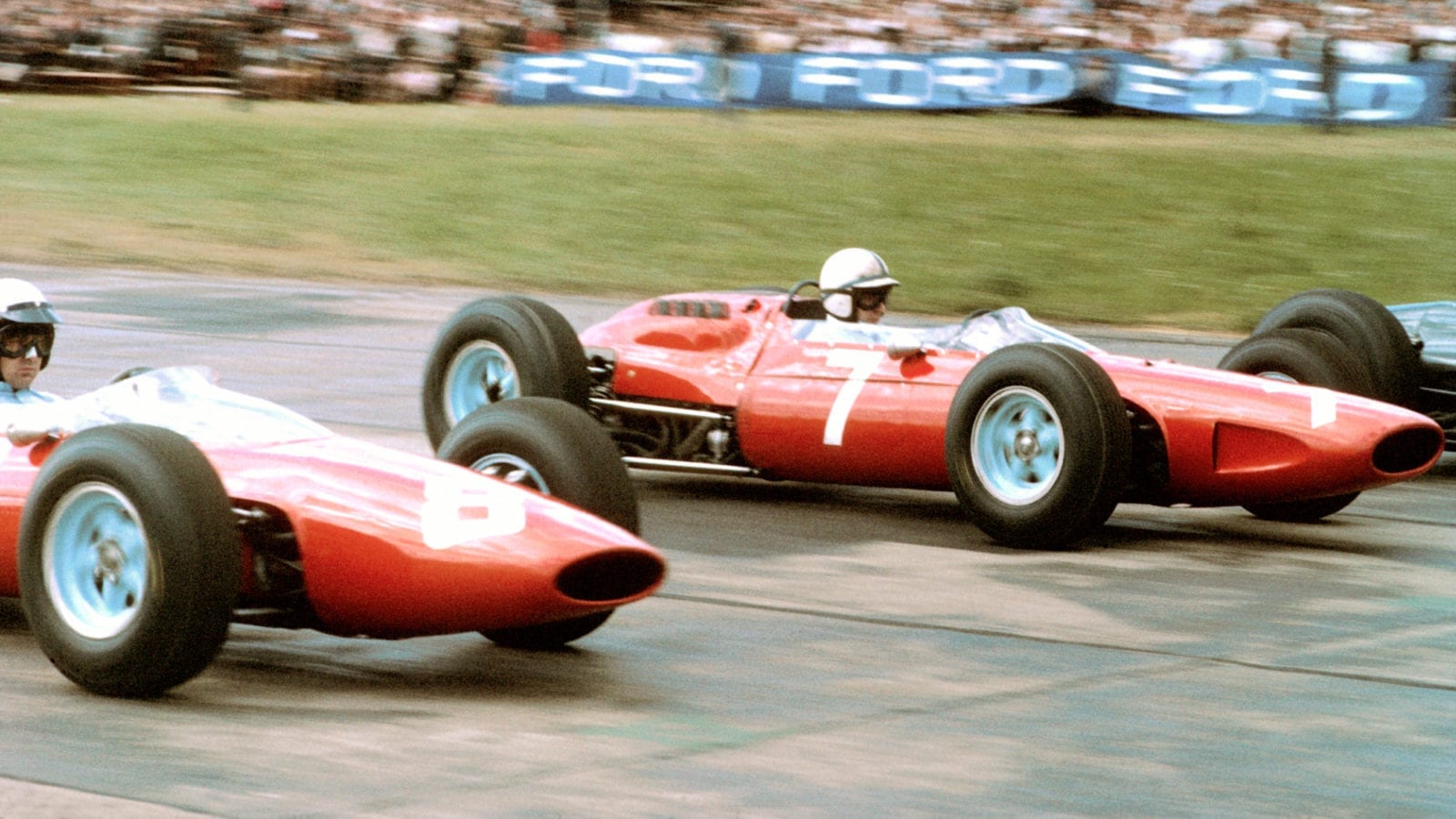
Surtees and Bandini side-by-side
GP Library/Universal Images Group via Getty Images
For the first time, Austria had an event ranking as a round in the World Championships and it was held on the military air field at Zeltweg, scene of a Formula One race last year, three Formula Two events before that, in 1959, ’60 and ’61, and two sports-car events in 1957 and 1958, so that in eight short years the local Club, supported by the National Automobile Club, have risen from nothing to a full-blooded Grand Prix. The enthusiasm and organisation have progressed accordingly, but the circuit, being a temporary one laid out on the runway and perimeter track of the airfield, has progressed hardly at all, in fact, the circuit as such has deteriorated into rough and bumpy concrete.
Zeltweg is a small village almost in the middle of Austria and it was a long trek for the racing transporters coming from England, and even longer for those coming from the Mediterranean Grand Prix at Enna, in Sicily, the week before. Most of the drivers, and other people involved in a Grand Prix, flew to Austria, and used hire cars, but quite a few people drove there, including Surtees who came from Modena in his 330GT Ferrari, while the ever resourceful Brabham arrived in his private aeroplane.
As in previous years, the paddock was in a vast hangar, which was fine until someone started a racing engine, and the pits were in the middle of the runway, between the up leg of the course and the down leg, so that before practice could begin on Friday afternoon there was a minor Grand Prix for transporters and private cars, from the paddock to the pits, via the circuit. With a lap length of only 3.2 kilometres, and a lap time of around 1min 10sec, the two hours’ practice provided on the first-afternoon was more than ample for drivers to find their way round, and for cars to be adjusted to the conditions.
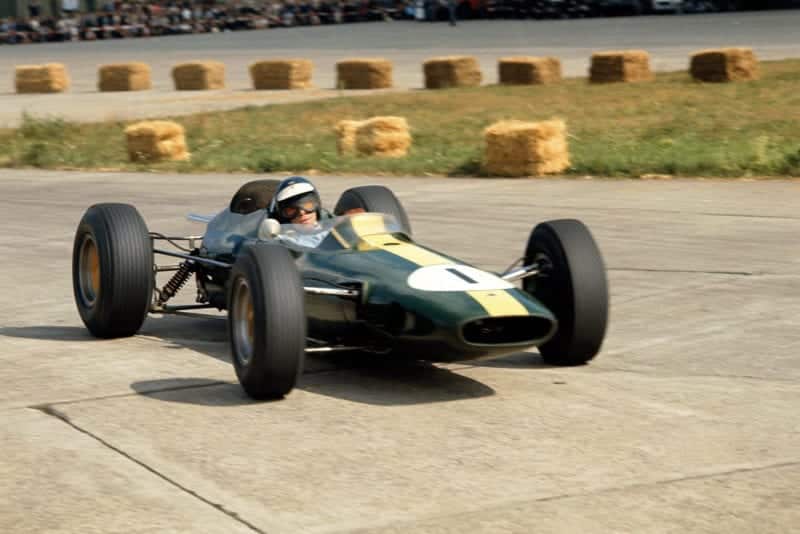
Jim Clark was racing the Lotus 33
Motorsport Images
Team Lotus had four cars with them, the latest Type 33, number R9, for Clark, the Solitude-winning Type 33 for Spence, still deputising for Arundell, Clark’s old modified Type 25 as a spare and the other Type 25, previously driven by Arundell, now on loan to the Parnell Team, Clark’s car was fitted with new drive-shafts made from 220S Mercedes-Benz shafts, and the spare car also had them on, as it had come direct from Enna, where Clark had driven it and tried the new shafts for the first time.
“The paddock was in a vast hangar, which was fine until someone started a racing engine”
The BRM team were not too happy, still having only two cars, for Graham Hill crashed one while testing at Snetterton and his Solitude-crashed car had to be hurriedly rebuilt for the Austrian race, this being the latest of the 1964 cars. Ginther had his usual 1964 car, and both cars were using the old-pattern gearboxes as they were going to need low first gears for the hairpin. Some new rear wheels were being tried with half-inch wider rims, in an effort to flatten the Dunlops even more across the tread.v
Brabham was driving his brand new Brabham, this being its first outing, and though virtually the same as previous cars it was tidied up in details, notably, the mess of small tubes just behind the cockpit had gone, the pannier tanks were slimmer and no longer formed the cockpit sides, there being fibreglass panels covering the tanks, and the panelling around the engine was much neater. Coventry-Climax V8 engine and 5-speed Hewland gearbox were used as before, but new tubular drive-shafts were fitted, with Hardy Spicer joints outboard and flexible Layrub joints inboard, there being no sliding joint; Gurney had the same car as he has been using all season.
The Ferrari team was as at Nürburgring, with two V8 cars for Surtees to choose from, and a V6 for Bandini, and all three cars were fitted with aluminium air scoops to the front brakes. McLaren and Phil Hill had the two 1964 works Coopers, with an old 1963 car as a standby, while the Walker team had a new addition to their ranks. RRC Walker bought the Brabham chassis, lets engine and gearbox, that Brabham himself had been using all season, and installed the V8 Climax engine and Colotti 6-speed gearbox from the team’s 1963 Cooper that Bonnier has driven on occasions. This new concoction was for Bonnier, as he could not get on too well with the high-revving BRM V8 engine in the new Brabham chassis that Walker bought earlier in the season. The Brabham-BRM V8, also with 6-speed Colotti gearbox, of the Walker team was on loan to the Formula Two driver Jochen Rindt, this being his local Grand Prix.
The British Racing Partnership had got themselves under control once more, after recent accidents, and both Ireland and Taylor were driving BRP monocoque cars, with BRM V8 engines and BRM gearboxes, but the Parnell team were rather disorganised. In Sicily Hailwood had put his car into the lake on the inside of the circuit and it had gone back to England to be dried out, so Parnell borrowed the fourth Team Lotus Type 25 works car, with Climax engine and ZF gearbox, and hurriedly painted it the Parnell team’s dark blue/green. Amon was using this car and his own Type 25, with BRM engine and Hewland gearbox, was driven by Hailwood.
The Centro-Sud BRM V8 cars were driven by Baghetti and Maggs, and Siffert, fresh from his win at Enna, and Anderson, with their private Brabhams, completed the field, the only non-arrival being Trintignant with his BRM V8. Originally only 18 out of the list of 21 were to be allowed to start, but this was changed later and all 20 runners were permitted to start.
Qualifying
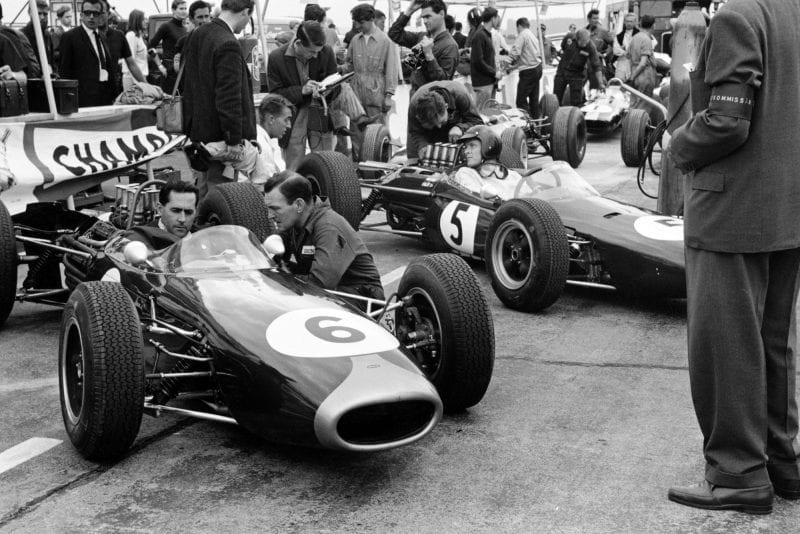
Brabham and Gurney prepare to leave the pits
Motorsport Images
Practice came to a sudden and early stop for Phil Hill when he hit the straw bales on the corner leading on to the runway on the that lap, the Cooper bouncing from bale to bale, breaking part of its right-hand front suspension and bending the rest. Bandini was not much happier for an oil leak developed down in front of the engine and could not be repaired at the pits. Surtees juggled about with the two V8 Ferraris, and Graham Hill was suffering from a stiff neck after his Snetterton accident and was wearing a chin support, while Gurney was in fine form and seemed to delight in chasing Suttees whenever he could.
Clark’s Lotus 33 was round behind the pits having a repair made to its throttle cable spring using the BRM team’s welding plant, and Ginther’s BRM was having its front anti-roll bar changed. The ribbed wash-board concrete surface was giving the cars and the drivers a bad time, with the high-frequency bumps and vibrations and handling was hopeless on most cars, especially at the hairpin, but Surtees, Gurney, Ginther and Graham Hill were indulging in a close battle amongst themselves for a time.
Later Ginther and Hill seemed to carve each other up, and then Ireland and Taylor seemed to do the same and it looked as though team discipline, if there ever was any, had gone by the board. Apart from the circuit being dead flat and rather dull, the corrugations were not making anyone any happier, and a gloom descended when first Clark broke his left-hand steering arm and then Ginther had his left front wheel break off around the stud holes.
The wide open spaces of the airfield encouraged drivers to go over the limit and be untidy in a sloppy manner, and quite a few indulged in harmless spins, some deliberately to find the limit, others by accident. Graham Hill was doing a great number of laps and to him was credited the fastest time, but as the electronic beam timer was not working, and hand-operated watches were being used, the organisers would not guarantee the times given.
“The wide open spaces of the airfield encouraged drivers to go over the limit and be untidy in a sloppy manner”
Before the next practice period, on Saturday afternoon, there was much work for the mechanics and a lot of parts were given close scrutiny for any signs of cracks appearing, while Lotus fitted new steering arms to Clark’s car, the new type drive-shafts to Spence’s car and Coopers “cobbled-up” their old 1963, car for Phil Hill to use. After the rush from paddock to pit area, there was a slight pause while everyone got organised and it was Bandini who was first away, followed by just about everybody else and the first four minutes of practice was pandemonium, with the whole circuit full of cars.
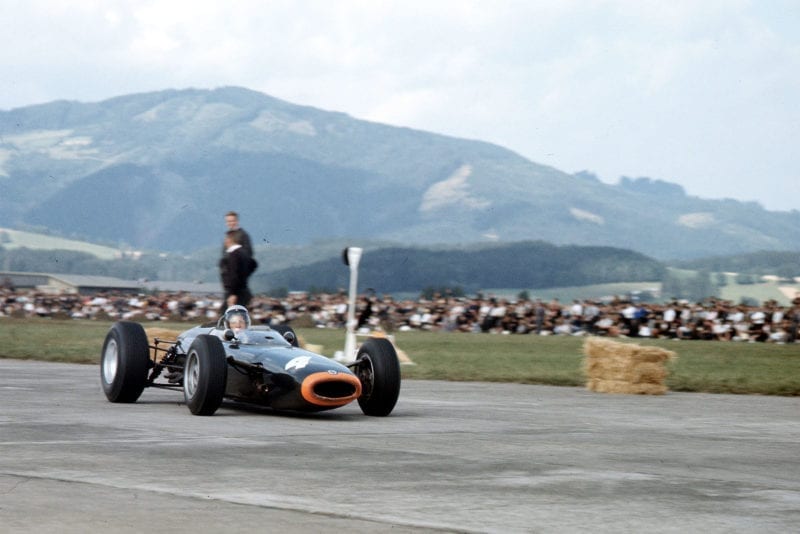
Ginther managed 5th in qualifying with his team-mate Hill on pole
Motorspoet Images
Clark was circulating slowly, running in a new gearbox, and keeping out of everyone’s way, and the activity was quite incredible, it seeming that no-one was going to stop. It may have been the short lap distance, or it may have been that everything was going well, but it was more likely the corrugated Surface throwing the cars about that was giving drivers little sense of time. However, a few Spots of rain began to fall and one by one the cars disappeared to the pits, until only the two works Coopers were left, but then the rain stopped and everyone came out again.
Surtees was putting in a great number of laps on both V8 Ferraris and Bandini was going well on the 6-cylinder car, while Graham Hill was as fast as ever. Clark finished bedding in his new gearbox and began to “turn up the wick,” but he had not done many fast laps before the steering felt peculiar and he stopped at the pits. Another steering arm had broken, in the same way as before, on the piece that was actually inside the hub-carrier. Gurney was also beginning to have a go, and sliding through the corners in real old-fashioned full-lock slides, but his progress ceased abruptly when the left-hand front suspension upright broke in two and the Brabham subsided on to the side of the track.
The BRMs were standing up well to the rough conditions and no matter how hard Graham Hill tried, nothing broke, nor did anything on the V8 Ferrari when Surtees did some really quick laps, and these two were fastest and safest. Among the lesser lights Amon had a steering arm break, as on Clark’s car, Bonnier was making good use of the new combination of parts that Team Walker had put together, driving the Brabham-Climax quite hard. Rindt was enjoying the power of a BRM V8 engine and was not afraid of it, and Anderson and Siffert seemed evenly matched.
As practice finished the rain came down and the evening saw more work for the mechanics, for Lotus had no more steering arms, new Brabham parts were on the way from England and everyone had to inspect everything for looseness or cracks. Team Lotus fudged up their two cars, using parts from the spare car and parts from the old Lotus 24 that BRP had with them as a spare, so that Clark’s Lotus 33 had a mixture of Lotus 24 and 25 front end and steering, and Spence’s Lotus 33 had a strong 1963 steering arm on the left and a lighter 1964 arm on the right, and both cars retained the new drive-shafts. Amon’s borrowed car was fitted with the uprights and steering arms off Revson’s Lotus 24, that the Parnell team had with them.
Race
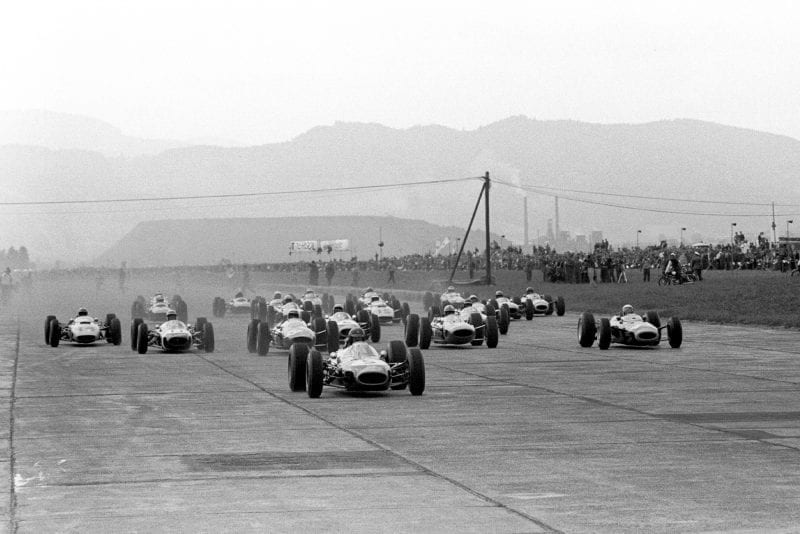
Gurney leads at the start
Motorsport Images
All the cars were repaired and sorted out by Sunday lunchtime, except that panic arose in the Ferrari camp when it was found that an injector nozzle had broken off in the cylinder block on the V8 that Surtees had decided to drive. While long, thin pliers, magnets and skinny fingers worked down amongst the Bosch fuel-injection mechanism on the damaged car, the other V8 was got ready, but Surtees was not happy as the second car had poor brakes.
Phil Hill still had the 1963 works Cooper and everyone else was as in practice, Lotus fitting overload fuel tanks as the race was over 105 laps of the 3.2-kilometre circuit. Rain had been threatening, but it held off and about one o’clock there was the final rush of transporters, private cars and racing cars from the paddock to the pits.
“Clark was in real trouble; he could not get into first gear as the flag was raised”
The best V8 Ferrari had been repaired, but just in case, both cars were taken out to the starting grid, and there was some chaos caused by the racing cars having to go straight to the “dummy grid” instead of the usual practice of going to the pits first, while drivers collected helmets and goggles and mechanics fiddled about with last-minute jobs. BRP had been surprisingly devoid of excitement until now, but on the line Taylor’s alternator stopped charging due to a slipping belt-drive, and Ireland’s car produced a puddle of water underneath. Fire-extinguisher fluid cured the slipping belt trouble; and Ireland’s car was only suffering from being over-full and soon settled down.
With one minute to go all the engines were running and the twenty cars moved up on to the proper grid and, as the flag, fell, Gurney and Surtees made good starts, Graham Hill got too much wheelspin and sat still while others went by, and Clark was in real trouble; he could not get into first gear as the flag was raised and when the start was given he was about to put his hand in the air to warn other drivers, when he tried second gear and it engaged.
By this time most people were well on the move and going past him so he gave the throttle a real boot-full and took off in second gear with prodigious wheelspin which he thought was clutch-slip! Alongside the Lotus 33 Graham Hill was making about as little headway, due to wheelspin, and the two of them were engulfed by the back-markers. Meanwhile Gurney and Surtees were leading the field away, the Brabham just in front of the V8 Ferrari, with the V6 Ferrari of Bandini in third place.
At the end of the lap Graham Hill was in eleventh place, and Clark in twelfth place, and Gurney and Surtees were not going to wait for them! In an even worse plight was Jack Brabham, whose new car was having fuel feed trouble and he stopped at the pits at the end of lap one, while Baghetti fouled-up the plugs of his red BRM and popped and banged for four laps before stopping for new plugs.
Surtees took the lead on lap two, and though Gurney had started on brand new tyres with the resolve to “take it easy”, he stayed with the Ferrari and the two of them began to draw away from the rest of the field, with the exception of Clark, who passed Graham Hill on lap two, Phil Hill on lap three, Siffert on lap four, and caught up with a bunch of the runners on lap five.
“As Surtees was braking for the hairpin there was a cloud of dust and a shower of sparks as the rear suspension collapsed”
These were Ginther, McLaren, Bonnier and Ireland, the four of them having a great battle, but Clark went through them with ease, passing Ireland on lap six, and the other three in the next two laps. However, trouble was beginning to strike in other parts of the field, Amon was finding the handling of his borrowed Lotus-Climax V8 a bit odd, and had an excursion on to the grass at the hairpin and a few laps later blew the engine up, which stopped him out on the circuit.
Graham Hill had his BRM engine cut out on him down the back straight on lap five, and coasted round to the pits, where it was found that the distributor drive had sheared, and on lap eight as Surtees was braking for the hairpin there was a cloud of dust and a shower of sparks as the rear suspension collapsed and the Ferrari scraped its underside along the concrete. This left Gurney comfortably in the lead and determined to go gently and not break the Brabham, but Clark was now third and on the next lap he passed Bandini and took second place, some 13sec behind the leading Brabham.
McLaren got his works Cooper away from the group he had been dicing with, leaving Bonnier, Ginther and Ireland still in very close company, the bearded Swede showing a new lease of life with the Brabham-Climax V8. Behind them came Siffert, but he was soon passed by Spence, the Team Lotus driver getting into his stride and closing up on the trio ahead of him.
At the back of the field there was a busy little hunch comprising Rindt (Brabham-BRM V8), Phil Hill (Cooper-Climax V8), Millwood (Lotus-BRM V8), Anderson (Brabham-Climax V8) and Maggs (BRM V8), while Taylor (BRP-BRM V8) was bringing up the rear, but then Anderson had a harmless spin which put him to the back and a few laps later Hailwood went by Phil Hill at the end of the main straight and promptly spun as they went into the long right-hand bend.
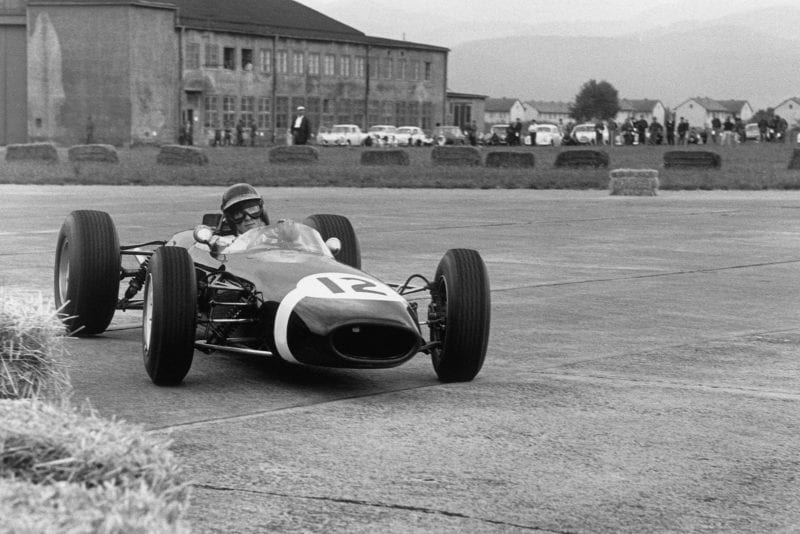
Rindt was the best of the back-markers until his retirement
Motorsport Images
While Hailwood spun right round and carried on, Hill had to take avoiding action and this put him off on to the grass and by the time he got going again he was at the end of the runners along with Anderson. Up in the lead Gurney was keeping an eye on Clark as they passed each other in opposite directions on the runway, and all the time the Lotus was gaining on the Brabham until the gap was down to 10sec on lap 23.
Brabham, himself, had joined in again at this point, but many laps down on the leader, and just as Gurney came up to lap Taylor the BRP broke a lower rear-wishbone mounting bolt on the chassis and the suspension collapsed, putting Taylor into a high-speed spin. Just as this happened he had moved over and waved Gurney through, which made the leader think it a strange method of moving out of the way!
Taylor came to rest undamaged and just before this Siffert had disappeared out on the course when his brakes played-up and he spun and hit a straw bale, damaging a front suspension and brake disc. With cars beginning to break things all round the course the leaders must have wondered when it would be their turn, but Clark still continued to reduce Gurney’s lead, the gap being 8½sec on lap 27. Steadily and securely in third and fourth places were Bandini (Ferrari V6) and McLaren (Cooper-Climax V8), but fifth place was still in dispute between Ginther, Spence, Bonnier and Ireland, the rest of the runners having now been lapped.
At 30 laps Clark was 9sec behind Gurney, and the American was beginning to look over his shoulder, but the gap did not get any smaller for Clark was easing off a little as a roughness was developing somewhere in the transmission. On lap 34 Clark was looking back at his rear suspension and drive-shafts as he accelerated out of the hairpin, and he was obviously worried about something and on lap 40, as he accelerated away from the hairpin a driveshaft broke, bits fell on the track, and he coasted to a stop at the pits, his race being over.
Gurney was now completely unchallenged and was able to go very gently and try his best not to impose any strains that might break something, for Bandini was too far behind to be a menace. However, he did only three laps in this relaxed fashion and then something felt peculiar about the front end and on lap 44 he was leaning forward peering at his front, suspension; on the next lap he was looking at the other side of the car, going quite slowly, and on lap 46 he headed for the pits for a closer look and a consultation with his mechanic. Bandini went into the lead, and Gurney rejoined the race, but only for another slow lap as something was definitely wrong and he went back to the pits again. A lower-front radius-arm was pulling away from its chassis mounting, and that was that.
“On lap 48 the order was completely changed, with Bandini leading from Ginther, Bonnier and Ireland”
While all this excitement had been going on among the leaders there was an equal amount of trouble among the other runners, for Ireland’s BRM engine had gone off-song and he had lost contact with Ginther, Spence and Bonnier, and McLaren’s Climax engine was also losing power and he dropped back from Bandini and was caught by Ginther and Bonnier, for the Swede had passed Spence when the Lotus driver had eased up a bit on feeling something odd going on at the rear of his car.
Just two laps after Clark had retired with a broken drive-shaft, Spence rounded the hairpin in the second Team Lotus car, there was a bang and he stopped on the grass verge also with a broken drive-shaft! At the same time McLaren drew slowly into the pits, his engine sounding rough, and after doing one more slow lap he retired before the engine damaged itself, so all of a sudden, on lap 48, the order was completely changed, with Bandini leading from Ginther, Bonnier and Ireland, but the BRP was sick and Ireland stopped at his pit to see if anything could be done; the trouble was a broken tappet so he limped on again, to nurse the car along, for anyone who could keep going was likely to be in the money.
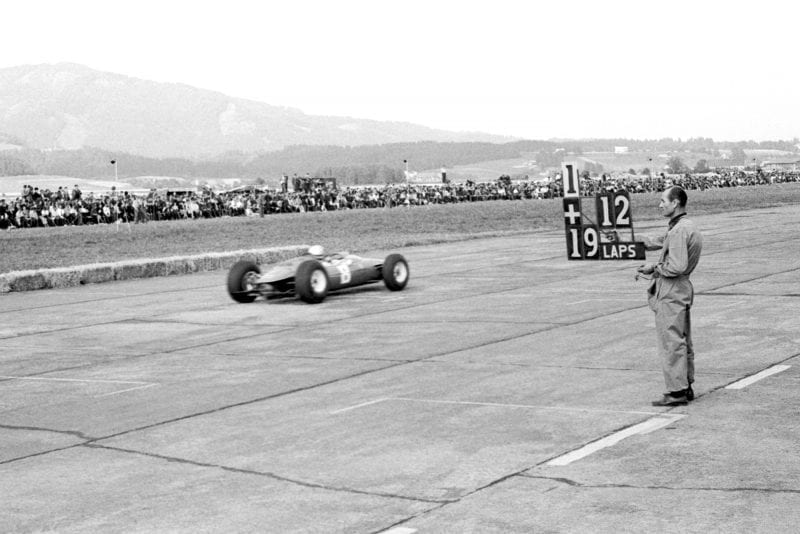
Bandini pulled out a comfortable lead
Motorsport Images.
Brabham was still circulating with this in mind, and Baghetti was also still running but a long way back, while Rindt rejoined the race, having been at the pits for a long while for attention to the brakes. Surtees had walked back to the pits after his Ferrari had collapsed, collected a jack, some spanners and spares, returned to the car and repaired the damage then drove round to the pits.
At 51 laps, which was not yet halfway, there were only eight left in the running, with Bandini, Ginther and Bonnier on the same lap, and Ireland. Hailwood, Anderson, Phil Hill and Maggs a lap behind; Brabham. Rindt and Baghetti were still circulating but many laps astray. Ginther was 15sec behind Bandini, and it looked as though the BRM could catch the Ferrari, but as soon as Ginther speeded up a little, Bandini did the same and the gap hovered around 12 and 13sec.
Ireland was slowing all the time and first Hailwood went past him and took fourth place, and then Anderson went by to take fifth place, the private-owner Brabham driver going well after his earlier spin. Phil Hill had been struggling along in seventh place with the old works Cooper, that had not only been giving him anxious moments, but also worrying some of the fast drivers when they came up behind, to lap it early in the race, until on lap 59 it got out of hand on the corner leading on to the runway, and struck the wall of straw bales. The rear suspension collapsed and fire broke out in the engine compartment, and Phil Hill got out very quickly but before any fire-extinguishers could get to work the whole car went up in a sheet of orange flame and clouds of smoke.
Now it was Hailwood’s turn for trouble and after a slow lap trying to see what was wrong with the rear suspension, he made a pit stop to have a radius arm re-fixed, and this dropped him well back behind the remaining runners, and let Anderson up into fourth place. At lap 60 Anderson had been lapped by Bandini and Ginther, and Bonnier came up to lap him, but the Rob Walker car was beginning to misfire and Bonnier limited himself to lower maximum rpm.
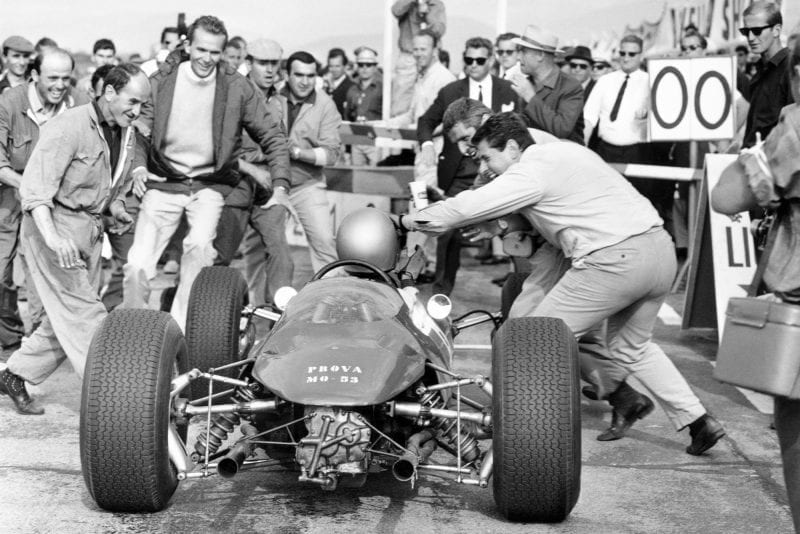
Bandini took a popular win
Motorsport Images
As a result Anderson stayed with him, and though a lap apart the two of them started having a private race, first one leading and then the other and this went on until lap 84 when Bonnier’s engine went really sick and the Brabham-Climax would only just drag itself along, so that Anderson not only went ahead, but made up a complete lap, took third place from the sick car and went on to make up another lap. Bonnier was going slower and slower and by the end of the race Maggs in the Centro-Sud BRM and Ireland in the sick BRP-BRM V8 both passed him.
At the front of the field the position remained unchanged, Ginther could do nothing about catching Bandini, and the young Italian made no mistakes and the Ferrari held together, the gap between the two cars sitting at around 12 to 14sec, until the end was in sight and Bandini toured in to win, letting Ginther close up to 6sec. The Italian team were delighted with this second Championship victory in a row and Bandini was a popular winner of this strange race that had been one of reliability rather than driver ability.
Anderson finished in a well-deserved third place and a lucky one for both his drive-shafts had split and broken rubber couplings, the drive being taken in a rather rough-and-ready fashion by the metal spiders. Brabham was still touring round at the finish, and Baghetti’s BRM was misfiring badly at the end, while Rindt had given up when the steering of the Brabham-BRM had jumped a tooth on the rack and pinion! It had certainly been a race with a difference and it left a lot of very disgruntled drivers, while nobody viewed the chassis-breaking surface with much favour, that sort of thing having disappeared from most European races many years ago.
